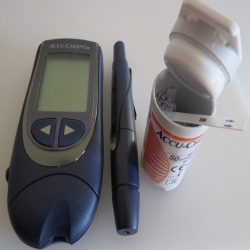Diabetes
 What is diabetes?
What is diabetes?
A disease characterized by insulin deficiency that leads to increased levels of sugar in the blood. It is medically termed diabetes mellitus. Its mechanism can be resumed in two ways, either by insufficient production of insulin by pancreas or the body's inability to use insulin despite its normal production thus the increase in blood sugar otherwise known as hyperglycemia.
Medical kits are available to measure glucose or sugar levels in blood. Confirm diabetes if value is equal or above 7mmol per liter on 2 separate tests. Sometimes symptoms may orient us to diabetes, though numbers never lie so to be absolutely certain, take a test if you happen to have symptoms or just need to know about your sugar levels.
There are three main types of diabetes. Diabetes type1: juvenile diabetes, insulin dependent or sometimes called early onset diabetes, is seen in teenagers or people less than 40 years old. Diabetes type2: diabetes non-insulin dependent is common in the elderly. Thirdly is gestational diabetes that occurs in pregnant women that have no history of diabetes. In most cases it disappears after delivery.
What causes diabetes?
Diabetes type1 is idiopathic, meaning its cause is unknown. Genetic factors however have been linked to this type of diabetes. Autoimmunity is also another factor, where the body's cells attack beta cells in the pancreas that make insulin. Without the beta cells, there is no insulin and glucose is in the body is not transported to tissues, or stored properly therefore this cause high levels of blood sugar. Viruses such as rubella, cytomegalovirus play a part in causing type1.
Diabetes type2 can be inherited, if you have a family history of diabetes then you are at risk. Being older than 45 years, hypertensive, overweight and having a sedentary lifestyle can put you at risk of having diabetes type2.
With gestational diabetes, pregnant women with a family history of diabetes are at risk of getting this type, chances increase if they are overweight, if they are carrying twins or more, and if they have had this type of diabetes in a previous pregnancy.
What are the symptoms of diabetes?
Frequent urination, unquenchable thirst and tending to be hungry after short while of eating. Dizziness, headaches, exhaustion and vision changes. Vaginal infection notably thrush can be a sign of diabetes. As diabetes progresses without treatment, wounds or cuts take prolonged duration of healing. Diabetes type1 is characterized by weight loss.
Natural treatments for diabetes
-Cinnamon: half a teaspoon of cinnamon powder into a mug of boiled water. Let it cool then drink daily.
-Bitter melon: lower sugar levels by inducing insulin production. Drink in the morning on an empty stomach. Continue for two months.
-Fenugreek seeds: known for its hypoglycemic properties and has fibers. It lowers glucose. Soak the seeds overnight. Drink the liquid in the morning before breakfast, chew the seeds as they would have softened by morning. Follow through for a month.
-Mango leaves: soak 20 leaves overnight. Drink the liquid only, on an empty stomach. Or you may grind the leaves into powder and eat twice daily, measuring 1 teaspoon every time.
-Guava: contains vitamin c and fibers good for regulating sugar levels in blood. Consume moderately at least not more than 5 guavas a day. Do not forget to peel skin off before consumption.
-Diet and exercise: reduce weight. Eat food low in fats and sugar, increase your fruit consumption especially apples, stock up on vegetables such as broccoli and spinach.